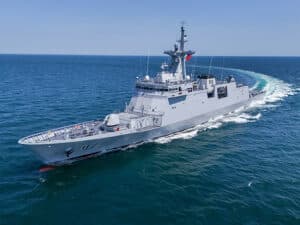
Q&A: Crew welfare in conflict zones and legal risks
Written by Heather Ervin
David Ashmore
The ongoing Iran–Israel conflict and the volatile situation in the Red Sea and Strait of Hormuz have intensified scrutiny of maritime risk zones. While the industry addresses insurance implications and routing strategies, a less discussed but critical concern lies in employment law and crew welfare.
David Ashmore, a London-based partner in the Labor & Employment and Shipping Groups at global law firm Reed Smith, spoke to Marine Log about how shipowners and charterers will want to take steps now to ensure crew welfare remains at the forefront of operational decisions.
Marine Log (ML): Are employment contracts compliant with ITF guidelines regarding a seafarer’s right to refuse to transit through conflict zones such as the Strait of Hormuz or Israeli ports?
David Ashmore (DA): Employment contracts should reflect the International Transport Workers’ Federation (ITF) position that seafarers have the right to refuse to enter the Strait of Hormuz and Israeli ports. The ITF has called for these areas to be designated as Warlike Operations Areas (WOAs), which would entitle seafarers to refuse to enter these zones or be repatriated without penalty. The Federation aims to ensure that seafarers “are informed of the risks, supported with appropriate protections, and have the right to protect themselves.”
ML: What legal obligations arise if a crew member invokes their right to be repatriated rather than enter a Warlike Operations Area (WOA)?
DA: If a seafarer invokes their right to be repatriated rather than enter a WOA, shipowners are under a duty to repatriate seafarers under the Maritime Labour Convention Minimum Requirement Regulations. This obligation applies whether the seafarers are employees or not. The shipowner must facilitate repatriation at no cost to the seafarer, especially when the vessel is heading towards a war zone without the seafarer’s consent.
ML: Under the Maritime Labour Convention (MLC), can refusal to work in a designated war zone be considered breach of contract or grounds for dismissal?
DA: Under the MLC, shipowners must repatriate seafarers who are no longer capable of performing their duties under their employment agreement or when it is unreasonable to expect them to do so, particularly if the vessel is heading towards a war zone without the seafarer’s consent. The Federation has asked for some High-Risk Areas to be designated as WOAs, which would mean seafarers could be repatriated without penalty. Therefore, refusal to work in a designated war zone should not be considered a breach of contract or grounds for dismissal.
ML: Are charterers contractually liable for increased wage obligations (e.g. hazard pay, double compensation) for seafarers operating in WOA or high-risk areas?
DA: Due to the designation of conflict zones as High-Risk Areas, shipowners of vessels passing through or entering these may have increased costs. Seafarers covered by IBP agreements are entitled to double their basic pay, along with double compensation for death or disability. If the vessel proceeds through an area exposed to war risks, charterers may be obliged to reimburse shipowners for any additional premiums required by the shipowners’ insurers and the costs of any additional insurances that the shipowners require in connection with war risks.
ML: What procedures are in place to ensure timely payment of enhanced wages or death/disability compensation where applicable?
DA: Employment contracts should be updated to reflect risk zones and compensation. Shipowners and charterers are advised to communicate clearly with crew about routing and safety provisions, and to ensure insurance (P&I and war risk) covers employment-related liabilities. This ensures that enhanced wages or compensation for death/disability are paid in accordance with contractual and regulatory requirements.
ML: How should employers handle situations where seafarers request reassignment or financial compensation due to anticipated war risks?
DA: Shipowners and charterers should ensure that seafarers are informed of the risks, supported with appropriate protections, and have the right to protect themselves. If seafarers request reassignment or financial compensation due to anticipated war risks, operators should update employment contracts to reflect these entitlements and communicate clearly with crew about their rights and available protections.
ML: If a ship must reroute due to conflict, how should shipowners handle repatriation responsibilities under the MLC if the new route extends beyond the seafarer’s original contract duration?
DA: If the vessel is required to reroute as a result of conflict zones and this leads to an extension of journey duration or expiration of the seafarers’ employment agreements, shipowners are obligated to facilitate the repatriation of the seafarers at no cost to the seafarer.
ML: Are there clear repatriation protocols for crew members who opt out of sailing into a newly declared war zone after boarding the vessel?
DA: Shipowners must repatriate seafarers who are no longer capable of performing their duties under their employment agreement or when it is unreasonable to expect them to do so, especially when the vessel is heading towards a war zone without the seafarer’s consent. The Federation has asked for some High-Risk Areas to be designated as WOAs, which would mean seafarers could be repatriated without penalty.
ML: How should shipowners document and process crew refusals or repatriation requests to protect themselves legally and operationally?
DA: Shipowners should update employment contracts to reflect risk zones and compensation, and communicate clearly with crew about routing and safety provisions. They should also check for liberty clauses in maritime contracts which allow a vessel to deviate from the agreed route or contract terms under specific circumstances. Proper documentation of crew refusals and repatriation requests is essential to protect shipowners legally and operationally.
ML: Does the charterparty include express war risk clauses that adequately allocate liabilities between shipowners and charterers for deviation, discharge of cargo, or seafarer entitlements?
DA: Many charterparties contain an express war risks clause which gives shipowners the right to refuse to proceed or continue to or through any port or zone where it appears that the vessel may be exposed to war risks. In such cases, the shipowners may discharge the cargo of the vessel at any safe port of their choosing, and the costs and expenses of doing so will be for the charterers’ account.
ML: Who bears the cost of crew repatriation, insurance surcharges, and additional wages if a vessel is diverted due to war risk—shipowner or charterer?
DA: If the vessel proceeds through an area exposed to war risks, charterers may be obliged to reimburse shipowners for any additional premiums required by the shipowners’ insurers and the costs of any additional insurances that the shipowners require in connection with war risks. The costs and expenses of discharging cargo at a safe port due to war risks will be for the charterers’ account.
ML: How can conflicting obligations under employment contracts (e.g. MLC or ITF CBA) and charterparty agreements be reconciled if the vessel must enter or avoid a conflict zone?
DA: Charterparty conflicts may arise regarding the MLC obligations, particularly in relation to the working and living conditions of seafarers entering High-Risk Areas. Shipowners must ensure that crew welfare remains at the forefront of operational decisions and that employment contracts and charterparty agreements are updated and aligned to reflect current risk zones and legal obligations.
ML: Have employment contracts been updated to reflect the latest Joint War Committee classifications and their legal and financial implications?
DA: Advice to shipowners and charterers is to update employment contracts to reflect risk zones and compensation, in line with the latest Joint War Committee classifications and their legal and financial implications. As of August 2025, the Joint War Committee lists the following as High-Risk Areas:
- Strait of Hormuz
- Bab el-Mandeb Strait / Southern Red Sea
- Gulf of Oman
- Parts of the Indian Ocean
ML: What steps are in place to ensure compliance with flag state and port state requirements concerning crew welfare in high-risk regions?
DA: Shipowners and charterers should ensure compliance with flag state requirements and the Maritime Labour Convention, and check for liberty clauses in maritime contracts which allow deviation from agreed routes or contract terms under specific circumstances.
ML: Is the company’s P&I and war risk insurance policy sufficient to cover liabilities arising from crew refusal, repatriation, or injury in war-risk areas?
DA: Operators are advised to ensure that insurance (P&I and war risk) covers employment-related liabilities, including those arising from crew refusal, repatriation, or injury in war-risk areas.

![Wärtsilä will supply an integrated hybrid propulsion system for the latest in a series of Aasen Shipping bulk carriers that includes the Aasvær, pictured here.. [Photo © Aasen Shipping]](https://www.marinelog.com/wp-content/uploads/2025/11/aasen-300x225.jpg)


![Artemis Technologies’ EF-12 Escape uses the patented eFoiler system, which enables vessels to foil above the water, reducing drag and delivering more than twice the efficiency of traditional diesel ferries. [Image: Artemis Techologies]](https://www.marinelog.com/wp-content/uploads/2025/11/PROPefoiler-300x225.jpg)